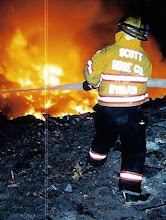The development of ALS while the most prominent and
recognized improvement is far from the only change. Ambulance services run by funeral directors
with a red light tossed onto the roof of a hearse have, thankfully, gone the
way of the horses. Overall
availability has improved as well.
How much? A lot. When I was six or seven years old, some
buddies and I were playing in the woods, jumping in piles of leaves and
generally doing the things young boys did back then when no one had to be
worried about us being kidnapped if we went ten minutes from the house. One boy jumped into a pile over a bank and
hit something hidden beneath the leaves, breaking his femur. His screams of pain frightened the living
hell out of the rest of us. There was no
thought of moving him, not because we knew not to, but because of fear. Practically as one, we all started running
for our respective homes for one thing; to get our mothers—it was the 60s, they
were home.
The group of mothers followed us back, and mine, being a
nurse, promptly recognized the fracture for what it was. An ambulance was called, but it wasn’t quite
as simple as today. The first due fire
department where Dad was a member had no ambulance or any medical capabilities
at all. No help there. The neighboring department had an ambulance,
but they only responded outside of their first due area on nights and
weekends. Monday through Friday, eight
to four, they didn’t leave the district.
In the next village over, the police department ran the ambulance. They didn’t leave their town at all,
regardless of time or day. The only unit
available was operated by the county Sheriff’s department. The road patrol deputy had to respond to get
the ambulance from wherever he happened to be, and then across half the county
to where we were waiting. This wasn’t a rural area either; the suburban
town had a population in the tens of thousands.
Almost an hour later, it arrived to transport the boy. Luckily the break hadn’t hit the artery or
he’d have been dead long before the unit arrived. After an extended convalescence; most of a
school year, he recovered.
Good? No, but normal
back then, so yes, things other than just ALS have changed a lot. As much as almost no one wants to be on the
ambulance every shift, I think everyone
would agree things are better now.




